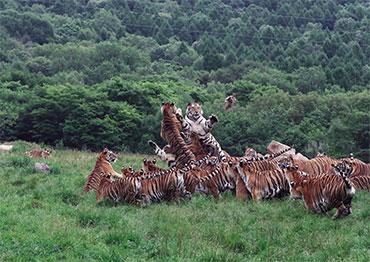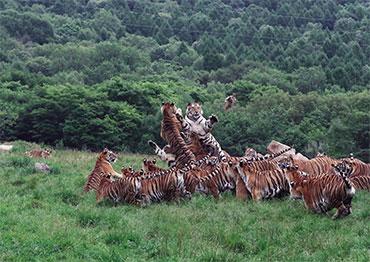After capture, the tiger was named Wanda Mountain No.1 and sent to quarantine for 45 days at Heilongjiang Amur Tiger Park. The forestry bureau said its health and behavior would be observed, and assured media they would release it.
“I just don’t understand why it has to wait 45 days before release ,” Shen Zhijun said. “The purpose of the rescue is to return it to the wild after a full checkup. It should be released as quickly as possible. As the tiger has no health problems, the longer it is in captivity, the harder it will be to survive in the wild in the future.”
Liu Dan, chief engineer with Heilongjiang Amur Tiger Park, told media that the quarantine was intended to ensure the tiger was not suffering from highly pathogenic avian influenza, rabies, cat plague, parasites or other diseases.
“Forty-five days is too long and wild animals would generate trust or hatred that they should never have, which then will lead to behavioral changes. They will be more daring in approaching humans,” Shen said.
“Every living individual has a special ecological value to the environment, not to mention the tiger at the top of the food chain, which belongs only to nature. At present, against the backdrop of Earth’s dwindling species and fragile ecological chain, saving and releasing these wild animals are ways to repair the fragile ecosystem,” he said.
“If we rescue a night heron or a turtledove, we will release them. Just recently, our zoo released some raptors such as the black eagle and Eurasian eagle-owl, although we know we can attract more visitors if we display such endangered species. After we assessed they could survive in the wild, we released them immediately. Why does the tiger need 45 days?” Shen said.
Chen Yuelong, a technician at a wildlife rescue center with Hongshan Zoo in Nanjing, told NewsChina that based on his extensive experience, the process for wildlife rescue is “physical examination, observation, treatment, rehabilitation, physical examination, evaluation and release.”
The principle is that release should happen as soon as possible if it is safe to do so and the wildlife meets the requirements, said Chen.
Addressing concerns over whether the tiger would attack people again, Song Dazhao said that except in some rare cases, most tigers do not develop the habit of attacking people. “The tiger’s attack on people in Mishan was not for hunting, but it could attack again if people disturb it like they did this time.”
“But these 45 days could increase the likelihood of it attacking people again as it will become habituated to humans providing food. So it may have a different reaction to meeting humans in the wild,” Zhou said.
“As long as the rescue and feeding measures are scientific, even if the tiger is in captivity for 45 days, it can still be released without becoming dependent on humans. But the process for rescue and feeding should proceed with caution. They should keep the tiger in isolation and prevent it from seeing humans when given food,” Chen Yuelong said.
“It was taken from the wild and it’s not accustomed to these living conditions and isolation. So the park must ensure it doesn’t become too stressed and remains psychologically stable,” Bao Weidong, Associate Professor of Zoology, School of Bioscience and Technology at Beijing Forestry University, told China Central Television (CCTV). He emphasized the need to keep the tiger isolated to allow it to return to the wild and not be affected by human interaction.
Although authorities had not confirmed as of press time when they will release the tiger or where, Song Dazhao believes he should be released in a reserve or forest where there is no competition from another male tiger.
The Amur Tiger Park must also provide an open evaluation of the tiger’s condition and make its conclusion in accord with current best practice.
As China continues to increase protection for animals like tigers, there are sure to be more incidents as their numbers increase. Coexisting with tigers will become a vital issue that residents of wild tiger habitats must address. Experts interviewed by NewsChina indicated that a combined system of early warning, rescue and preventive mechanisms should be established to prevent other incidents like these.

 Old Version
Old Version


